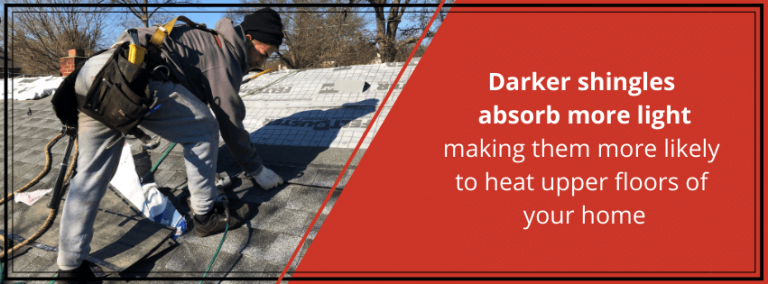The color of your roof’s shingles will have the most impact on the highest rooms in your house. Your attic alone can have temperatures that fluctuate 20 to 40 degrees in difference. Whether you are running the air conditioner or the heater, your home’s HVAC system may have to work harder depending on the color of your roof.
Selecting your roofing material and color of chosen material is a big decision during your roof replacement process! While you want your shingles to look aesthetically pleasing, you want to make sure you’re choosing an energy efficient option to save money on heating and cooling bills in the long run. We have information below that you can consider before making your final shingle color decision.
How Different Colored Shingles React with Light
Darker shingle colors, such as black shingles, absorb more light, making them more likely to heat your attic or upstairs rooms when the sun is shining. Light colored shingles, like white shingles, won’t absorb as much heat keeping the upstairs areas cooler in the sun. After the sun has set, black shingles don’t retain the heat as long as white shingles do. Therefore, black shingles will cool off faster than white shingles do.

How Your Climate Impacts Which Shingle Color is Most Energy Efficient
That being said, your shingle color selection could depend on the climate you live in. If you have been in your home for a year or so, you are familiar with the weather patterns of your area. If you just moved into your new home, you can speak to your neighbors or search on Google to determine what kind of weather you can expect your home to withstand.
Roofs in a Warmer Climate
Living in a city that experiences a lot of sun and hardly any snow, if any at all, is considered a warmer climate. In this instance, you should consider selecting a lighter shingle color. Your lighter shingles won’t absorb as much heat and can save your air conditioning from working overtime to cool the entire home.
If you have hot summers, but still experience cooler months of the year, you could consider getting a gray colored roof as a good in-between.

Roofs in a Colder Climate
If you anticipate snowfall to occur sometime throughout the year, you are living in a cooler climate. During spring, fall, and winter months, a darker colored shingle roof could provide “free heat” by providing warmth from sunlight absorption. In the fall and spring, temperatures are relatively cool, so having some heat getting pulled in from the shingle absorption is a bonus. Because of the heat that darker shingles retain during the day, snow is able to melt faster as long as there is sunlight exposure.
How your roof melts snow and ice could be telling of your attic ventilation efficiency. Have a professional roofer inspect your attic to determine if ventilation alterations are needed!
It’s Not Just About Color
It’s not just about color. You can also consider the type of material you’re going to install. Rubber and metal roofing are more reflective than asphalt shingles. This means that mild colored shingled roofs still may absorb more heat than a dark colored metal roof.
Shingle manufacturers could have energy efficient options. GAF offers a line of shingles, Timberline Cool Series, that could save an average of 7-15% on cooling costs.
Talk to a Professional
In southcentral and southeastern PA, there are many shingle options that can suit your home and be efficient. You’ll want to consider all of the factors above prior to moving forward with a reroof of your shingles! We are excited to talk to you about your roofing needs.
Pennsylvania Home Improvement Contractor License (HIC) # PA124258


